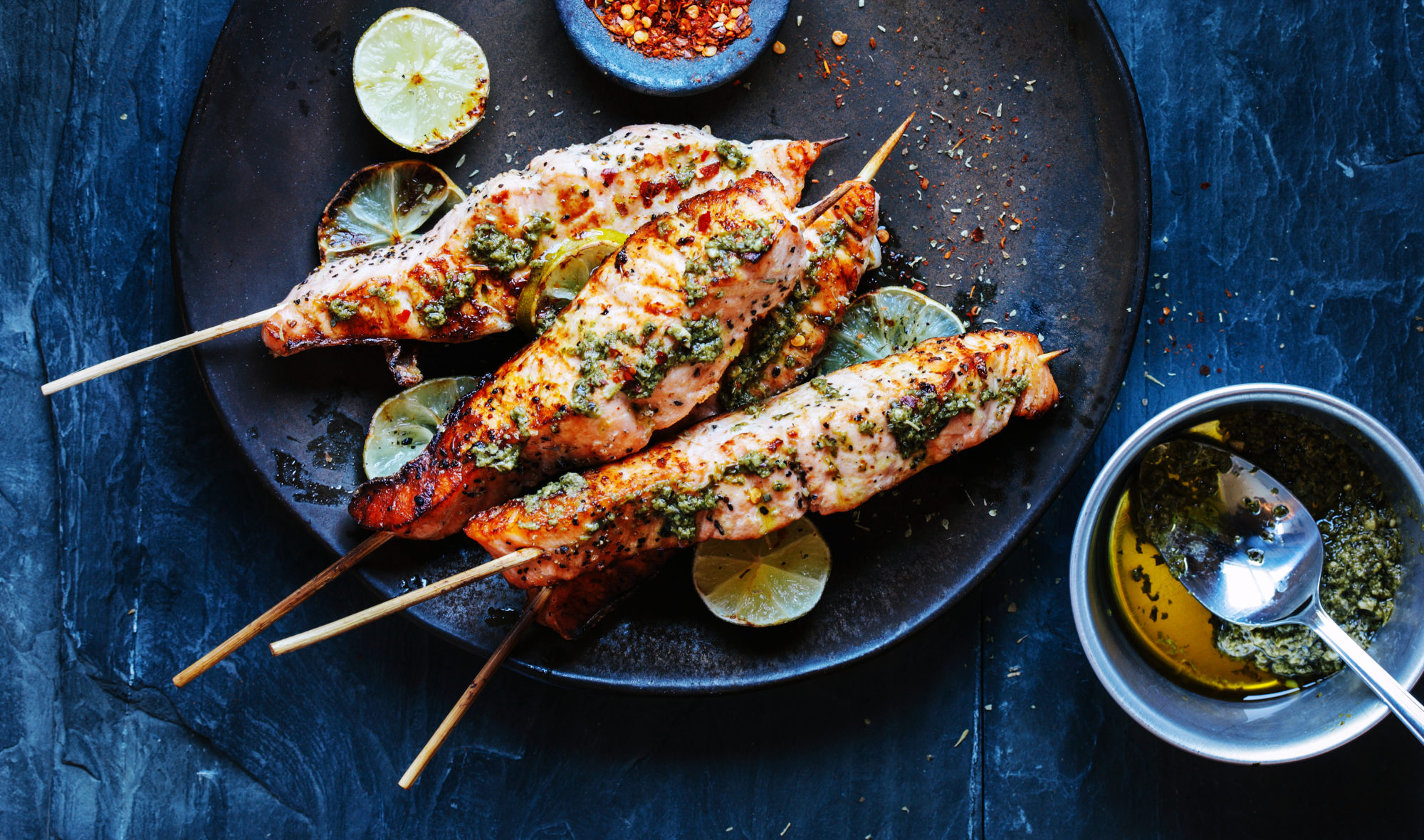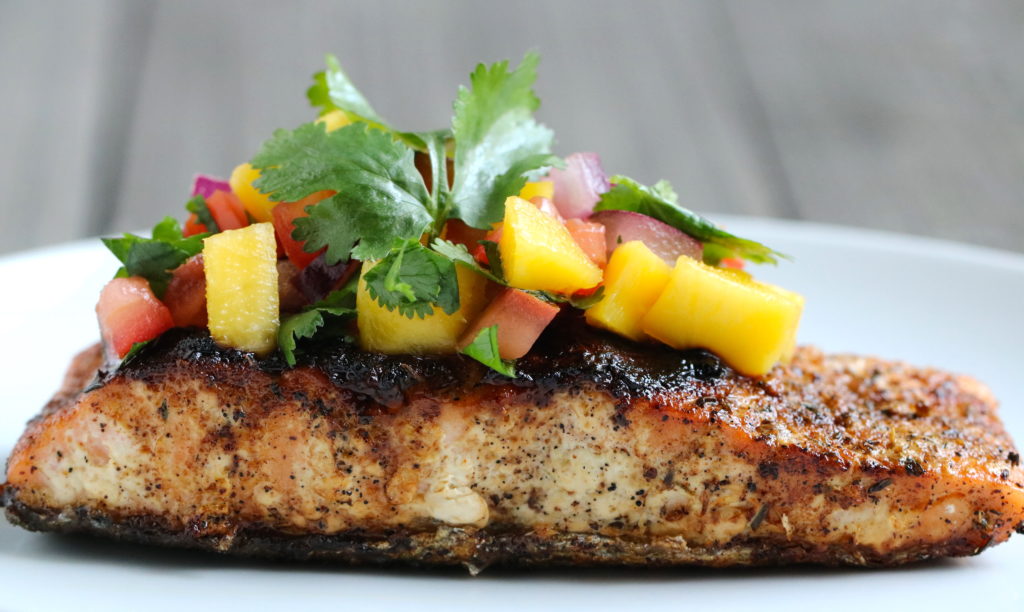
Join PN Level 2 for about $6/day! Plus, FREE Bonus worth $697! (This week only.)

Salmon is not one fish, but many. Atlantic salmon, Chinook salmon, hum salmon, coho salmon, masu salmon, pink salmon, sockeye salmon, and Danube salmon are all members of the family. Nutritionally, salmon is best known for its rich amounts of omega 3 fatty acids. It is also a good source of vitamin B12, selenium, and vitamin D. Although salmon is well-loved for its nutritional value and deliciousness, the most impressive part about this fish is its life story: Wild salmon are born in fresh water, migrate to open oceans, and once they reach sexual maturity, make incredible journeys sometimes spanning hundreds of miles against strong currents and raging rapids, only to return to the place they were born to spawn, and then in most cases, die. Next time you find salmon on your plate, bow down to the resilient fish that it was.
Call out “Salmon” and about eight species of fish will answer: Atlantic salmon, chinook salmon, chum salmon, coho salmon, masu salmon, pink salmon, sockeye salmon, and Danube salmon.
Wild salmon are found in both the Atlantic and Pacific Oceans, as well as in fresh waters in eastern North America, Northern Europe, and South America. Salmon is also farmed around the world. Farmed salmon now accounts for about 80% of the world’s salmon supply.
While this article mainly concerns the nutritional value of salmon, the life cycle of this resilient fish is worth highlighting:
Although some species are restricted to the same body of water their entire lives, most salmon are born in fresh water, migrate to the ocean, and then return to fresh water to spawn. Relying on olfactory memory to find their way, salmon often return to the exact spot where they themselves were spawned.
During their migration from the ocean back to fresh water, salmon make amazing journeys that span hundreds of miles against rapids and forceful currents. Once they spawn, the vast majority of salmon die.
This migration is also known as the “salmon run”, which is a predictable, seasonal event usually occurring between September and November. This is an exciting event for hungry bears, predatorial birds, and sports fisherman.
Like most cold water fish, salmon are fatty (particularly in omega 3 fats) and delicious, with iconic coral-pink flesh.
Salmon is a large fish. Depending on the species, a salmon can range from about 20 inches up to several feet long, and can weigh anywhere from four to over a hundred pounds.
In color, salmon flesh ranges from pale pink to sunset orange to a deep coral-red. Their skin is dark and slightly silvery, and will crisp up when applied to heat.
When raw, a salmon filet will display white lines running across its flesh. This is fat. Wild salmon will generally not exhibit this build-up of fat between its muscles.
Salmon is a favorite among fish lovers and has a rich, fishy flavor and, when cooked properly, a soft, moist, luxurious texture.
Three ounces (about 85g) of cooked wild Atlantic salmon* has 155 calories, 21.6g protein, 6.9g of fat, and no carbohydrates, fiber, or sugar. Salmon is an excellent source of vitamin B12, selenium, and vitamin D, and a good source of vitamin B3 (niacin) and phosphorus.
Nutritionally, farmed salmon is different from wild salmon. Compared to their farmed equivalents, wild salmon are richer in omega 3 fats and the carotenoids (particularly astaxanthin) that give them their vibrant coral color.
*Nutritional content may vary slightly species to species.
Salmon is widely available (in some form) in most North American food purveyors. Higher quality, wild, fresh varieties may only be available in specialty stores and fish markets.
Salmon comes in many different forms: Fresh / raw, frozen, pre-cooked, canned, dried, or smoked. Fresh or frozen varieties, which may be sold as steaks, fillets, or chunks, are usually the best choices as they are the least likely to contain added ingredients. However, other varieties can be great to have on hand for convenience sake.
If your salmon comes in a package, read the ingredients. Avoid products that add dyes or have long lists of unpronounceable ingredients.
Fresh salmon should be displayed over ice and should look moist, but not wet, with little separation between the muscle fibers. If you can smell it, give it a whiff. Fresh salmon should have only a faint, but pleasant and fresh fish smell. Trust your nose. If it smells “off”, look elsewhere.
The length of time fresh salmon can be stored depends on when the fish was caught, so that is useful information to obtain at the time of purchase. Generally, salmon can be kept (well-wrapped in plastic and preferably over ice) in the fridge for about five days after it is caught. If you don’t know when it was caught, eat it within a day or two.
Salmon can also be frozen for about two months. Wrap it well to prevent freezer burn.
Once it is cooked, salmon can be kept in an airtight container in the fridge for five to six days, or in the freezer for a few months.
If you have bought salmon in a package, follow the package directions for storage information.
Fresh salmon, if the quality is high enough, can actually be eaten raw. Salmon of this caliber will usually be labelled as “sushi / sashimi grade”.
Otherwise, salmon can be cooked.
Fresh salmon cooks quickly, especially if it is cut in fillets or smaller chunks. Salmon steaks, due to their thickness and the presence of the bone, will take longer.
A fresh salmon fillet may be simply prepared on the stove-top. To do this, place some butter or olive oil in a skillet over medium high heat. Wait until the oil is popping before placing the salmon in the pan, as this will help to prevent sticking. Cook on one side for about four minutes, or until this side turns golden brown. Flip it over and cook for another three minutes or so, or until the flesh feels firm and has lost its translucency. Season with salt, pepper, and a squeeze of fresh citrus, and serve.

Next time you buy salmon fillets, try this recipe! The hint of spice paired with the sweet and refreshing salsa is sure to please your taste buds.
Prep Time: 10 minutes Cook Time: 20 minutes Yield: 2 servings
Begin by dicing up ingredients for the fruit salsa – mango, tomatoes, red onion, and cilantro. Put diced ingredients into a bowl and add the lime juice and a small pinch of salt. Let sit.
Next, mix together all of the spices and coat each salmon on the flesh side. On a BBQ or stove-top grill (if stove top add 1 tbsp olive oil to the pan) – grill skin down for 15 minutes on low-medium heat, flip over and cook another 5 minutes. If the fish needs longer to cook – flip back to the skin side and continue cooking – it should no longer be pink inside.
Top fish with salsa and additional cilantro if desired.
Enjoy!
Precision Nutrition’s Encyclopedia of Food expands every single month as we highlight new foods and showcase beautiful food photography. If you’d like to stay up to date, simply click this link. From there, we’ll send you a FREE copy of our recipe book. We’ll also let you know when new and delicious foods are added to the site.
Salmon is not one fish, but many. Atlantic salmon, Chinook salmon, hum salmon, coho salmon, masu salmon, pink salmon, sockeye salmon, and Danube salmon are all members of the family. Nutritionally, salmon is best known for its rich amounts of omega 3 fatty acids. It is also a good source of vitamin B12, selenium, and vitamin D. Although salmon is well-loved for its nutritional value and deliciousness, the most impressive part about this fish is its life story: Wild salmon are born in fresh water, migrate to open oceans, and once they reach sexual maturity, make incredible journeys sometimes spanning hundreds of miles against strong currents and raging rapids, only to return to the place they were born to spawn, and then in most cases, die. Next time you find salmon on your plate, bow down to the resilient fish that it was.